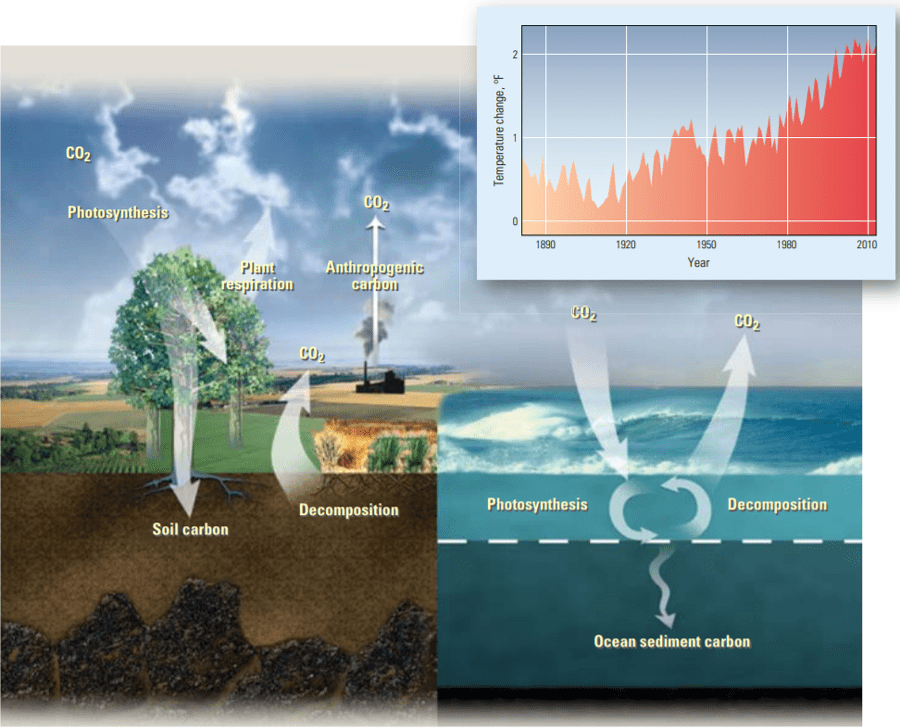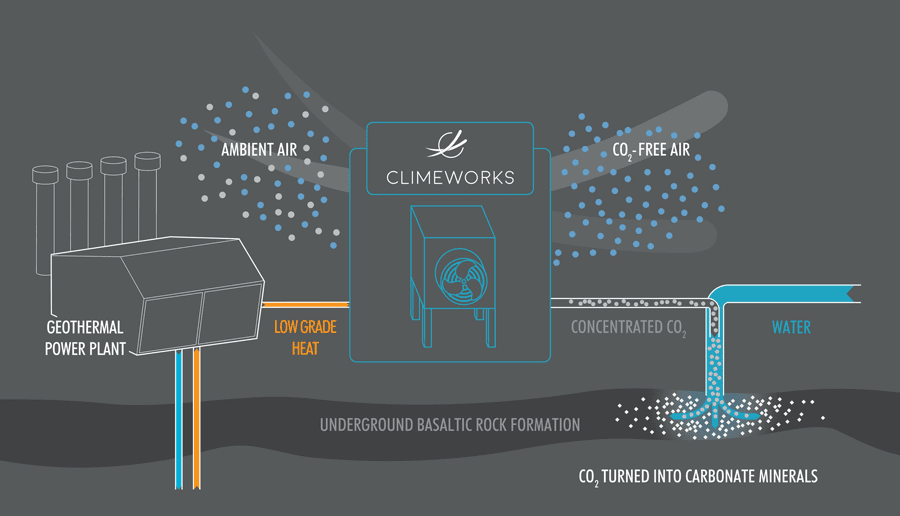One industry that will be worth about 1.4 trillion dollars by 2050, and which as of today has reached the significant investment figure of $300 million, is the carbon capture and storage (CCS) industry. This was mentioned in the report created by Vivid Economics titled Greenness of Stimulus Index in 2020. In this way, this powerful industry branch is expected to reach the annual value of the oil and gas industry.
The presence of carbon is a necessity and has always been present in the globe; it is the fourth most abundant element on Earth and is essential for life. It is the basis of carbohydrates, proteins and nucleic acids that all living beings on the planet need to live, grow and reproduce.
From the beginning of time, the presence of carbon has been in the atmosphere, plants, soil, animals, shallow and deep ocean, minerals, coal, oil and gas. Therefore, it can be classified as an essential element on Earth, so much so that the amount of this element is equal to 5.37 x 10 16 kg [11.83 x 10 16 lbm], distributed as explained above.
During Earth’s time, carbon has maintained two cycles: slow and fast, with the slow cycle taking between 100 and 200 years. It is where carbon moves from the waters to the soil, then to the rocks and finally reaches the atmosphere. The fast cycle consists of 50-100 years and is responsible for bringing carbon into the biosphere.
The easiest cycle to alter is the fast cycle. The amount of carbon generated over the past 100 years has increased dramatically due to activities such as deforestation and combustion of fossil fuels. These activities tend to generate burned carbon CO2, which accumulates in the atmosphere. At the same time, the increase in CO2 due to anthropogenic activities also accumulates in the atmosphere, thus altering the equilibrium, since only 55 percent of this CO2 is absorbed by plants and oceans, leaving 45 percent that travels directly to the atmosphere, increasing environmental adverse effects.

The infographic developed by Schlumberger shows the two cycles of natural carbon formation, as well as how the temperature has been increasing over time, and the increase of carbon generating processes. Despite this, there are solutions in the industry today for capturing this element.
Ways to Capture Carbon
Trees and Forestation
As mentioned previously, 55 percent of the carbon produced is treated naturally; the existence of forests is of immense importance in this process. With the use of the photosynthesis process, trees and plants can store large amounts of carbon per year, absorbing carbon through their leaves and directing it toward the roots while releasing clean oxygen.
According to a study by the World Resources Institute (WRI), the carbon-removal potential from forests and trees in the United States alone is more than half a gigaton per year, making this method as the most economical on the market, with the ability to remove a metric ton of carbon per year for $50.
Bioenergy with Carbon Capture and Storage (BECCS)
Based on capturing carbon before it enters the atmosphere, possible with the use of biomass, BECCS focuses on the heaviest emitters, such as large industries, transportation and power generation plants, with the use of controlled photosynthesis. This method, despite being expensive, is one of the most recognized in the fight to save the environment and focus on carbon as a profitable economic source.
Direct Air Capture
With the use of chemical processes, carbon is captured directly from the air and then stored properly. Although similar to the carbon capture and storage method, it removes carbon directly from the air thus helping to decrease the amount of this pollutant in the atmosphere. It requires a significant amount of energy to operate: 10 percent of the current energy consumption consumed in the U.S. to remove approximately one gigaton of carbon. A 2018 WRI study states that $94 to $232 should be invested per metric ton of absorbed carbon, substantial numbers for our times, while it is a necessity to clean up the air we breathe. For that reason, in 2019 the U.S. Congress approved $60 million for carbon removal technologies.

What Can Be Done with Carbon?
Farming and Agriculture
Agricultural soils are an important market when storing carbon. This is because one of the most important elements when growing a crop is carbon. At the same time, it is the most non-existent given that the repetitive use of the land creates a mineral deficit. Storing carbon in agricultural plant soils ultimately adds yield to crops and nutrients to food.
Carbon Mineralization
A natural process of CO2 with some minerals allows the gaseous phase of carbon to be changed to a solid state, i.e., it converts it into a carbonate. This process, known as meteorization, is one of the reasons why large hydrocarbon deposits have formed, but this process takes hundreds or thousands of years to happen naturally.
Using the same principle of natural mineralization, but this time applying it artificially to speed up the procedure, in 2012 researchers at the University of Pittsburgh used aminization, nitrification and ammonification to turn this polluting gas into an underground functional solid that will change metamorphic and igneous rocks to carbonate rocks over time. Even more important, it would be possible to trap the carbon and not contaminate the atmosphere.

A Great Business for Oil and Gas Companies
One of the best examples that explains the business of capturing and storing carbon for oil and gas companies is the agreement maintained by the Norwegian government with companies engaged in the hydrocarbons sector since 1996, which states that taxes are reduced for companies that capture and store carbon resulting from their operations.
Another company involved in the capture and storage of CO2 is Occidental Petroleum Corp (Oxy), which expects that within 15 to 20 years its most important business will go from oil extraction to carbon removal and storage from operations and from the air.
The main investment of this company today is a carbon capture plant located in the Permian Basin in the U.S. Taking up the largest hydrocarbon production field in the country, it is expected to collect one million tons of carbon dioxide per year, which is approximately equal to what 215,000 cars produce per year. This investment is expensive, so external investments and tax credits are expected to achieve this goal.
Another high-impact strategy comes from Silicon Valley where Chevron Corp will partner with Microsoft Corp, Schlumberger NV and Clean Energy Systems to create a carbon capture and storage plant that will use 200,000 tons of agricultural waste and remove approximately 300,000 tons of carbon dioxide per year.
The announcement of the California Air Resources Control Board launch in February 2021 caused plans to speed up and these large companies to begin work, as the target date for phasing out the burning of agricultural waste in the Valley is 2025.
Another of the oil giants in the carbon removal race is ExxonMobil. In February 2021, the company announced a $3 billion investment in energy projects, called ExxonMobil Low Carbon Solutions, to reduce carbon emissions. Working to cover more than 20 countries, it is based on the method of capturing carbon before it reaches the atmosphere, which involves placing its operations in the industrial plants with the greatest impact.
Despite not having a presence as an oil company, the Carbfix company is a pioneer in carbon capture, as it is one of the European companies with the greatest number of capture methods for different industries. Taking into account where the source of carbon is located, it develops the best form of carbon capture and, additionally, provides support for the correct method of storage or mobilization, depending on the conditions of the location.
The companies investing the most in carbon capture and storage worldwide are the companies linked to the oil and gas sector because they have the economic power to face such a challenge. On the other hand, there is the environmental debt they have with the world.
They also take into consideration that by 2050 carbon capture and storage are expected to have a significant space in resource energy, as this element can be sold to as many industries as oil is today. In addition, the reduction of taxes posed by some countries generates an attractive outlook for these companies.
Headline photo courtesy of Adobe Stock/Jon Anders Wiken
Andres Ocando is a 30-year old petroleum engineer, who has been working for PDVSA for five years, facing positions such as reservoir engineer and geomechanical engineer. He currently works as a project analysis engineer. There, he has optimized the data collection process for the development of geomechanical models. Ocando has experience in copywriting and is currently a technical writer on topics related to the oil and technology industries. He collaborates for important technical publications such as OILMAN Magazine and SPE. Quality and responsibility are two words that describe him perfectly. Ocando is currently pursuing higher studies at the University of Zulia to obtain his master’s degree in petroleum engineering.





